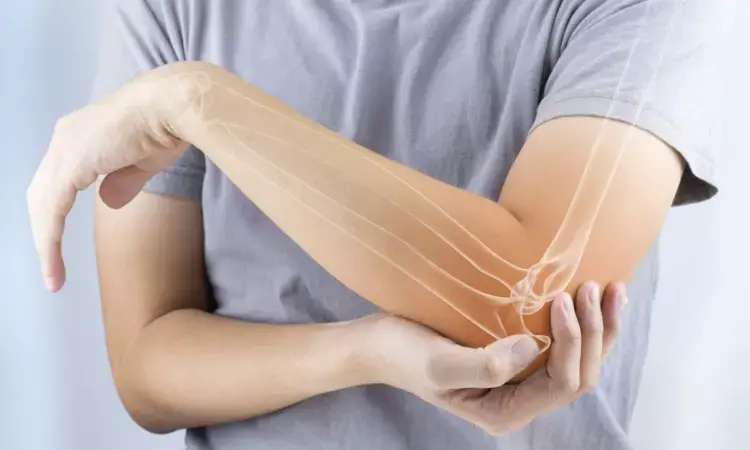- Home
- Medical news & Guidelines
- Anesthesiology
- Cardiology and CTVS
- Critical Care
- Dentistry
- Dermatology
- Diabetes and Endocrinology
- ENT
- Gastroenterology
- Medicine
- Nephrology
- Neurology
- Obstretics-Gynaecology
- Oncology
- Ophthalmology
- Orthopaedics
- Pediatrics-Neonatology
- Psychiatry
- Pulmonology
- Radiology
- Surgery
- Urology
- Laboratory Medicine
- Diet
- Nursing
- Paramedical
- Physiotherapy
- Health news
- Fact Check
- Bone Health Fact Check
- Brain Health Fact Check
- Cancer Related Fact Check
- Child Care Fact Check
- Dental and oral health fact check
- Diabetes and metabolic health fact check
- Diet and Nutrition Fact Check
- Eye and ENT Care Fact Check
- Fitness fact check
- Gut health fact check
- Heart health fact check
- Kidney health fact check
- Medical education fact check
- Men's health fact check
- Respiratory fact check
- Skin and hair care fact check
- Vaccine and Immunization fact check
- Women's health fact check
- AYUSH
- State News
- Andaman and Nicobar Islands
- Andhra Pradesh
- Arunachal Pradesh
- Assam
- Bihar
- Chandigarh
- Chattisgarh
- Dadra and Nagar Haveli
- Daman and Diu
- Delhi
- Goa
- Gujarat
- Haryana
- Himachal Pradesh
- Jammu & Kashmir
- Jharkhand
- Karnataka
- Kerala
- Ladakh
- Lakshadweep
- Madhya Pradesh
- Maharashtra
- Manipur
- Meghalaya
- Mizoram
- Nagaland
- Odisha
- Puducherry
- Punjab
- Rajasthan
- Sikkim
- Tamil Nadu
- Telangana
- Tripura
- Uttar Pradesh
- Uttrakhand
- West Bengal
- Medical Education
- Industry
Despite Strong BMD, Fracture Risk High in T2DM: Indian Review Urges Better Screening

India: A recent review published in Apollo Medicine has spotlighted a lesser-known complication of type 2 diabetes mellitus (T2DM) -its adverse impact on bone health. The review, led by Dr. Lakshmi Nagendra from the Department of Endocrinology, JSS Medical College, Mysore, draws attention to the paradoxical observation that individuals with T2DM often present with normal or elevated bone mineral density (BMD) yet face a substantially higher risk of fractures.
“This review draws attention to a critical and often overlooked paradox in T2DM: patients may have normal or even high BMD, yet remain at significantly increased risk for fractures,” Dr. Lakshmi shared with Medical Dialogues. She added that this mismatch is driven primarily by compromised bone quality and microarchitectural deterioration, which weaken bone strength despite normal BMD readings.
The study further explains that diabetic complications such as neuropathy, retinopathy, and medication-induced hypoglycemia increase the risk of falls, compounding the risk of fractures. Traditional diagnostic approaches like dual-energy X-ray absorptiometry (DXA) and the Fracture Risk Assessment Tool (FRAX), which primarily focus on BMD, may fail to detect the underlying bone fragility in diabetic patients.
“DXA does not capture bone quality, and FRAX underestimates risk because it doesn’t consider diabetes as a standalone factor,” Dr. Lakshmi noted.
To address these limitations, newer diagnostic tools are gaining attention. The Trabecular Bone Score (TBS), derived from DXA scans, assesses bone microarchitecture, offering a more comprehensive understanding of bone strength. Vertebral Fracture Assessment (VFA), a simple DXA add-on, can detect silent vertebral fractures, common in T2DM but often overlooked in routine practice. However, access to these technologies remains limited in many clinical settings.
Looking ahead, the authors advocate for more research to refine fracture risk prediction models tailored specifically to diabetic populations. Diabetes-specific corrections to FRAX may help with better risk assessment. Incorporating diabetes-related variables - such as disease duration, glycemic control, or TBS - into tools like FRAX may enhance their accuracy. Long-term studies are also needed to better understand how bone health evolves in T2DM over time.
Dr. Lakshmi emphasized the importance of individualized care, saying, “Personalized treatment pathways that take into account not just BMD, but also glycemic control, medication use, and microvascular complications, will be crucial for effective fracture prevention.”
In terms of clinical management, the review recommends earlier screening for high-risk diabetic individuals and emphasizes not just pharmacologic interventions but also strategies to minimize fall risk. Bone turnover markers, though often low in T2DM, may still help monitor treatment adherence. Where available, integrating tools like TBS and VFA into routine evaluations can identify patients who may otherwise go undetected.
The study emphasizes the urgent need to rethink conventional approaches to bone health in diabetes, moving beyond BMD alone and embracing a more holistic, diabetes-specific strategy.
Reference:
Nagendra, L., & Bhattacharya, S. (2025). Assessment of Bone Health in Type 2 Diabetes Mellitus. Apollo Medicine. https://doi.org/10.1177/09760016251330356
Dr Kamal Kant Kohli-MBBS, DTCD- a chest specialist with more than 30 years of practice and a flair for writing clinical articles, Dr Kamal Kant Kohli joined Medical Dialogues as a Chief Editor of Medical News. Besides writing articles, as an editor, he proofreads and verifies all the medical content published on Medical Dialogues including those coming from journals, studies,medical conferences,guidelines etc. Email: drkohli@medicaldialogues.in. Contact no. 011-43720751


